Wood Burning Outdoor Fireplaces
Compare wood vs. gas fireplaces and see why a combination of both is best
-
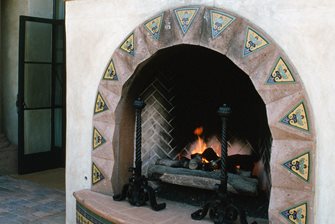 This larger firebox allows for large beautifully crafted andirons that give the interior of the firebox more visual appeal when flames are low.
This larger firebox allows for large beautifully crafted andirons that give the interior of the firebox more visual appeal when flames are low.
-
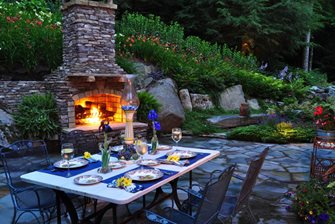 The heat and visibility of wood fireplaces are far more dramatic than gas fired units, although most can be fitted to allow both wood and gas.
The heat and visibility of wood fireplaces are far more dramatic than gas fired units, although most can be fitted to allow both wood and gas.
-
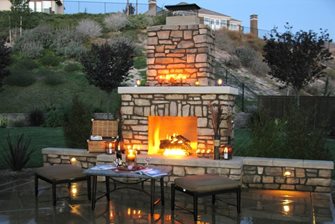 The height of this chimney with its fire safe cap ensures that smoke will rise freely and be less inclined to cause problems if wind direction blows it back toward the patio.
The height of this chimney with its fire safe cap ensures that smoke will rise freely and be less inclined to cause problems if wind direction blows it back toward the patio.
-
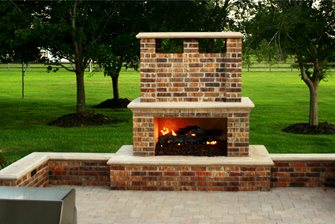 This ultra-wide firebox allows for much longer logs to be used, which eliminates the need to split or cut wood into pieces in order to fit it into a smaller box.
This ultra-wide firebox allows for much longer logs to be used, which eliminates the need to split or cut wood into pieces in order to fit it into a smaller box.
-
 When viewed from a long distance, the large wood firebox of this fireplace ensures the flames can be enjoyed from anywhere in this densely designed view lot landscape.
When viewed from a long distance, the large wood firebox of this fireplace ensures the flames can be enjoyed from anywhere in this densely designed view lot landscape.
- 1
- 2
- 3
- 4
- 5
An optimal outdoor fireplace allows you to choice whether to burn wood or to use gas for an easy source of heat. But when gas isn't an option, then a wood burning fireplace is the best choice. This option is ideal for regions or larger homesites where firewood is plentiful and cheap. It may be the only choice on sites where gas or propane installation is costly or unavailable altogether.
Wood burning fireplaces are controversial due to smoke and fire hazard. This makes them undesirable in cities where air quality is a serious problem. Many of these communities outlaw wood burning fireplaces both indoors and out, or they limit burning to certain days when conditions carry smoke out of the area.
But smoke is a bigger problem on a more intimate scale. A fireplace has a chimney which raises the source up so the adjacent living spaces are free of lingering smoke. However, your neighbors might experience the drift should prevailing breezes drive it in a particular direction. Beware of this to avoid conflicts.
Wood burning units are particularly undesirable in high wildfire hazard zones. Even with a spark arrestor, outdoor fires and their embers can be difficult to control, particularly when the wind kicks up. For this reason they are often banned from areas with a great deal of forest or chaparral surrounding residential areas that can become the source of a damaging fire.
In high fire regions the building code may be very specific about the kids of spark arrestors allowed for the chimney. The spark arrestor is vital to preventing embers from floating into adjacent wildlands or structures. Failure to add one to your project can result in significant liability.
FirewoodFor fireplaces that burn wood, you must have a ready supply of fuel on hand. That makes storage spaces an important part of the design. These fireplaces are often constructed with large open boxes that hold a great supply of wood, which costs money to create. A more affordable option is to design the space so there's an area behind a wall or the fireplace itself that is dry and large enough to store wood. While wood in side boxes is not unappealing to look at, it can increase maintenance when rodents and insects decide to take up residence there.
This is why a built in box provided with secure doors keeps wood dry in all weather so the wood remains easy to start. Secure enclosure also helps keep pests out of the wood supply. Failure to provide this source close to the fireplace could mean repeated trips to bring in more logs from a satellite wood pile. While it's not a huge inconvenience, it can be a burden while entertaining.
Firewood storage is key to safety as well. It eliminates loose firewood stacks close to outdoor living spaces that can become problematic for foot traffic. They're also highly unattractive when protected from rain by tarps. A fireplace can consume an amazing amount of wood over the course of a long evening of use, so the more storage area provided, the longer your fire lasts without hauling in fresh fuel.
|
Contributing Author: Maureen Gilmer, contributing writer for Landscaping Network, author and syndicated columnist |



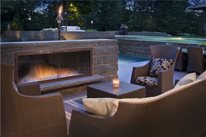 Outdoor Fireplaces
Outdoor Fireplaces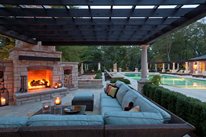 Gas Fireplaces
Gas Fireplaces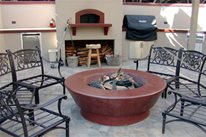 Wood Burning Fire Pits
Wood Burning Fire Pits

